Spring sights in the garden
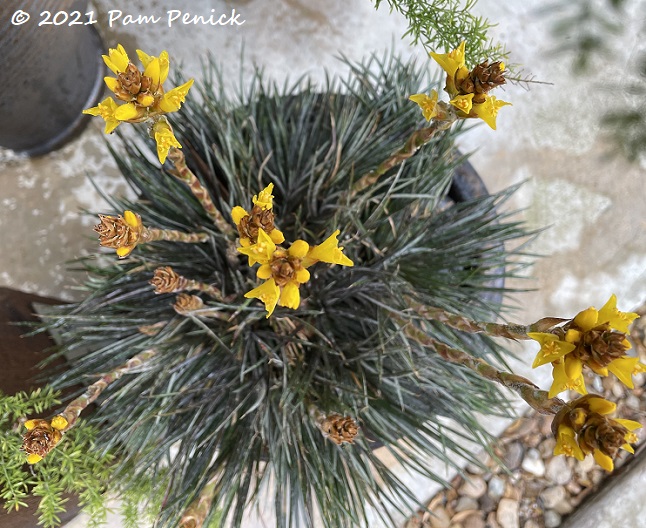
My spring planting is done, and I think all my post-freeze cutting back is done too. There are still brown shrubs and dead-looking small trees (like a pomegranate coming back from the roots, with a few leaves here and there on upper branches) taking up visual space, but I’m willing to let those be through the summer, just in case they magically find the strength to releaf. If they don’t, I’ll deal with it in the fall. I’m at peace with that and am simply enjoying the plants that are looking happy, or that are valiantly coming back from the roots.
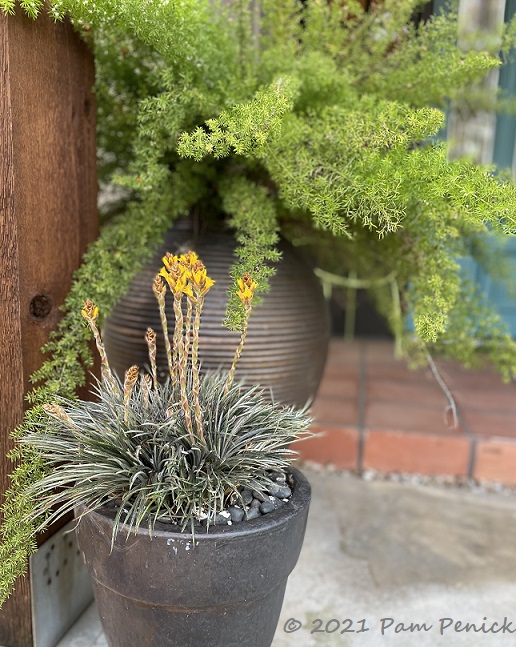
I’m also enjoying replacement plants, like this scruffy little ‘Frazzle Dazzle’ dyckia in bloom on the front porch.
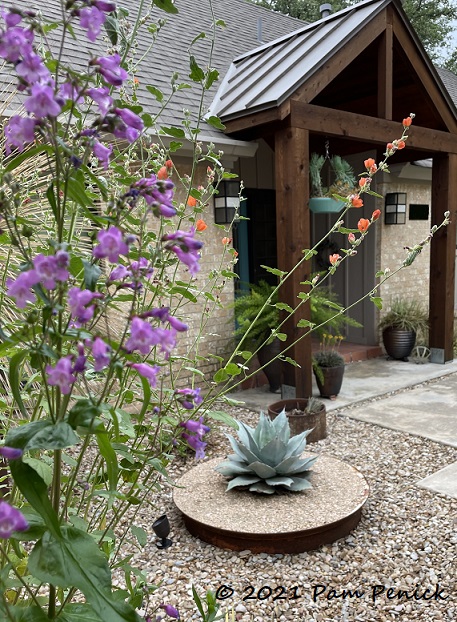
Globemallow (Sphaeralcea ambigua) and Gulf Coast penstemon (Penstemon tenuis), planted in a pot this year, add color to the gravel garden.
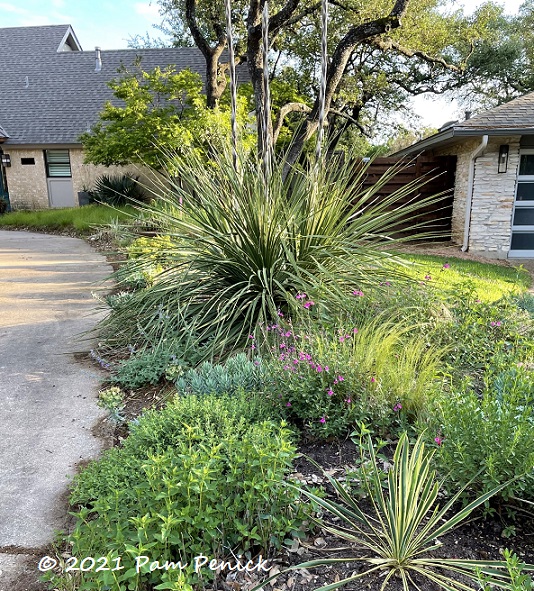
The driveway garden has recovered quickly, with autumn sage (Salvia greggii) blooming alongside wispy Mexican feathergrass (Nassella tenuissima). Purple skullcap (Scutellaria wrightii) is almost in bloom. And spherical, spiky Texas sotol (Dasylirion texana) is sending up three spear-like bloom spikes.
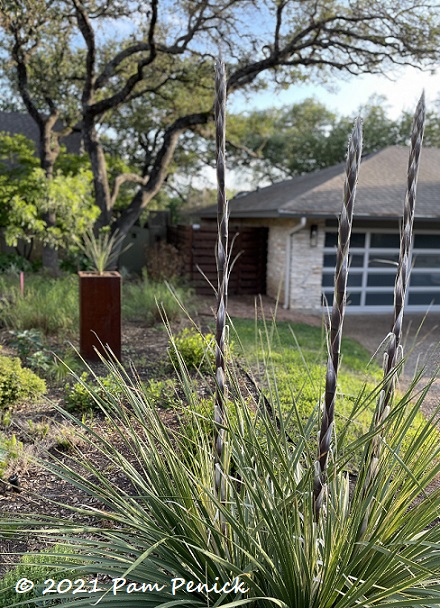
I took this photo last week. The lavender-tinged spikes are already a couple feet taller now.
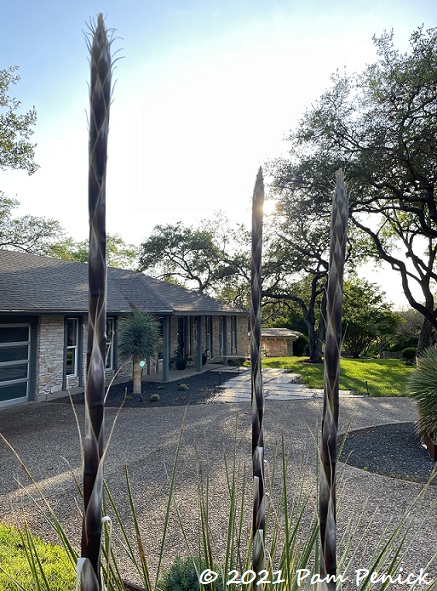
I can’t wait to see them in full bloom.
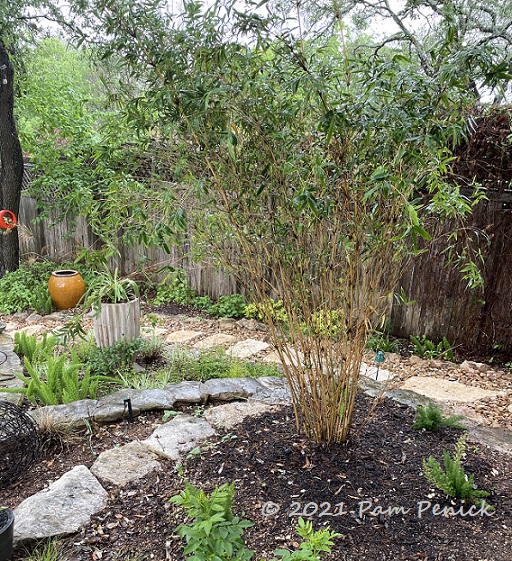
Where I took out a big whale’s tongue agave — the one that got badly freeze-burned — I’ve planted a new ‘Alphonse Karr’ bamboo (a clumper, not a runner). It’ll screen the afternoon sun for our new covered patio and (I hope) create a sense of mystery as you enter the back garden by obscuring part of the view.
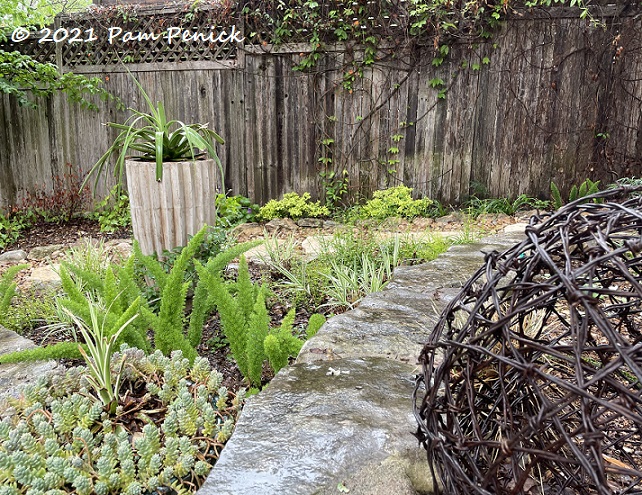
Just below it in the terraced beds, feathery foxtail ferns and creamy-striped ‘Sparkler’ sedges are coming back fast from the roots. And the once-stunning squid agave in the tall pot, which suffered amputated arms, is looking like a survivor. I’m hopeful she’ll be beautiful again one day!
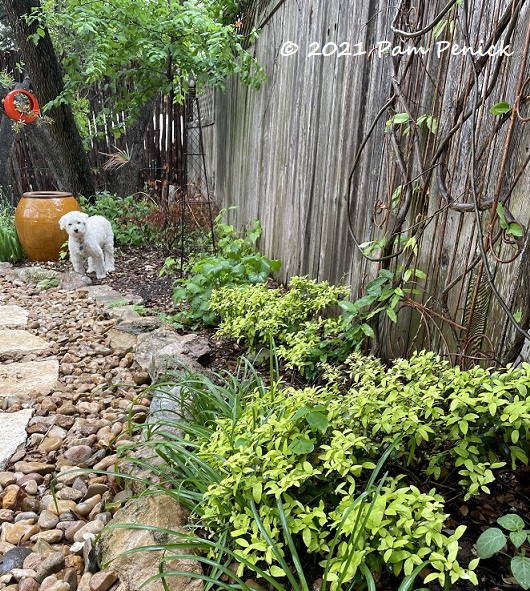
I’m really enjoying these little ‘Eureka Gold’ yaupon hollies (Ilex vomitoria ‘Eureka Gold’) — dwarf shrubs with an epically slow growth rate — which glow gold in spring. As it heats up they’ll turn a regular green, but they sure add zingy color now.
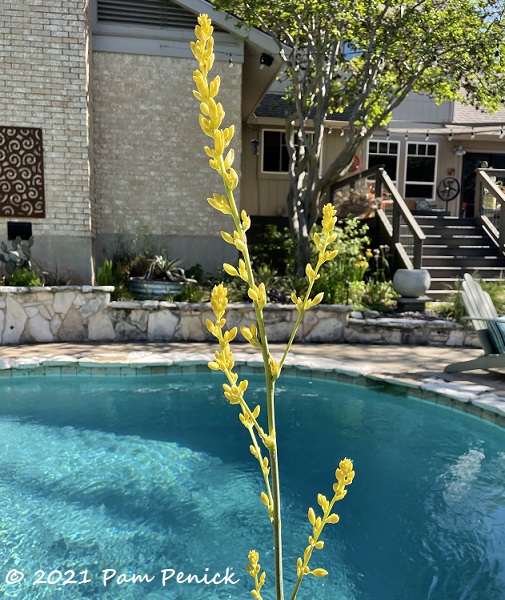
All my yellow hesperaloes (Hesperaloe parviflora ‘Yellow’) have sent up sunshine-bright bloom spikes. So pretty against the blue pool!
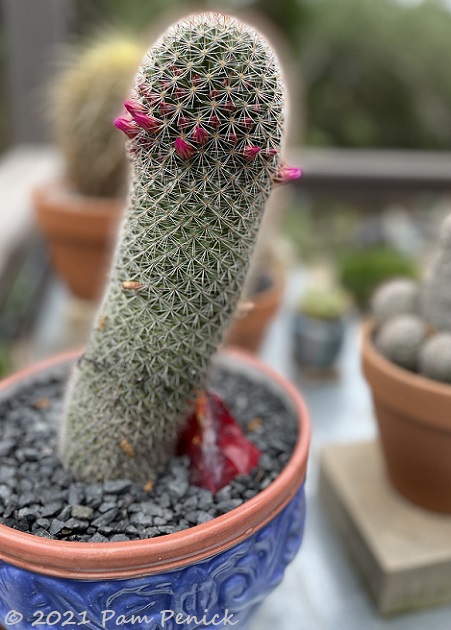
A few plants on the cactus table up on the hot, sunny deck have started to bloom. I’ll keep an eye out for more.
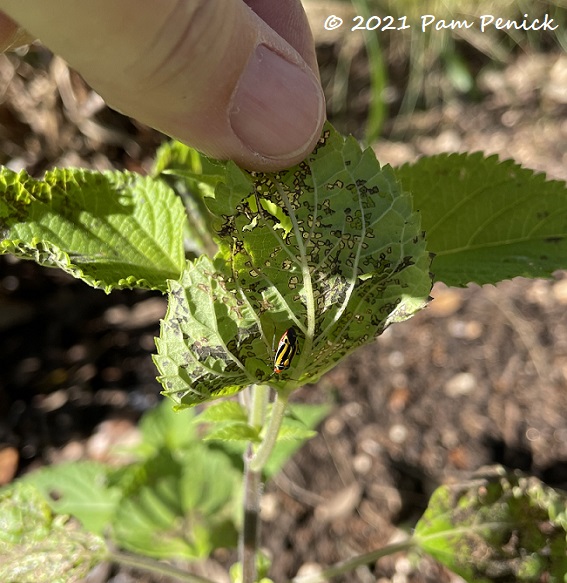
One development I’ve not been happy about: damage to many of my recovering perennials by this sneaky pest, the four-lined plant bug. They dart under the leaves whenever I snoop around to see what’s happening.
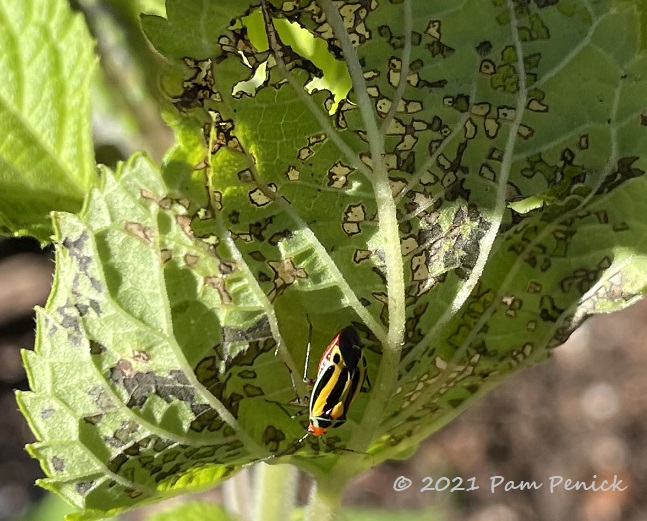
As you can see, they do quite a number on tender, new leaves, feeding largely on my Salvia greggii, Jerusalem sage, and ‘Amistad’ salvia. I read that they don’t feed for too many weeks, and by the time it gets hot they’ve laid eggs and died, so if you can tolerate the damage for a while they’ll be gone — at least until next year. It’s better than spraying poison everywhere, although I might try knocking them into a bucket of soapy water one morning to see if that helps. If anyone has a better suggestion, I’d love to hear it!
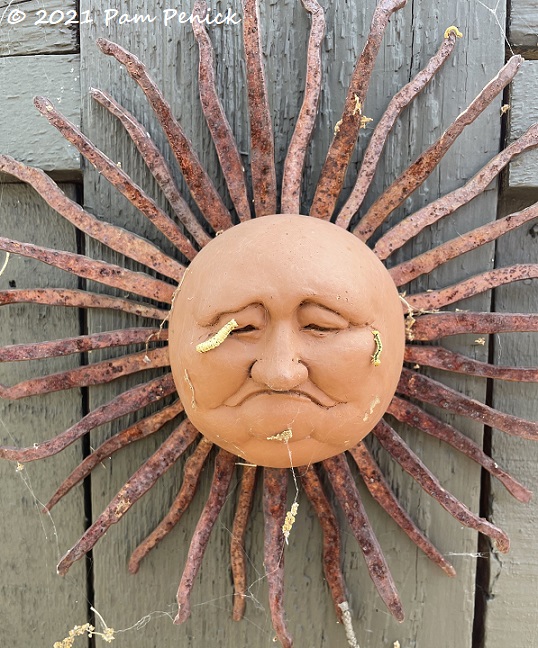
So it goes in the spring garden. New growth, spring flowers, pesky insects, and — for those gardening under Texas live oaks — an avalanche of oak pollen and caterpillars hanging from silk strands. That’s all cleaned up now, but here’s an image from the height of it, which evokes the delight of walking through the garden in late-March to early April — ha!
__________________________
Digging Deeper
Come learn about gardening and design at Garden Spark! I organize in-person talks by inspiring designers, landscape architects, authors, and gardeners a few times a year in Austin. These are limited-attendance events that sell out quickly, so join the Garden Spark email list to be notified in advance; simply click this link and ask to be added. Season 8 kicks off in fall 2024. Stay tuned for more info!
All material © 2025 by Pam Penick for Digging. Unauthorized reproduction prohibited.


For those pests – try a spray of strong cool coffee. It has worked well for me. Good luck, Debby
Interesting! Thanks, Debby.
I’m glad you’re enjoying the positives your garden has to offer, Pam. I appreciated the appearance by Cosmo too! The Dasylirion blooms are impressive. Mine (D. longissimum) has never produced a bloom spike.
I have D. longissimum too — or did, before the big freeze — and it never bloomed either.
So lovely & hopeful! Thank you, Pam!
As much as I’ve found it useful to catalog the freeze damage, it’s much more pleasant to focus on plants that are doing just fine, like these!
Your garden is looking beautiful! You must have been working very hard the past month or two.
Thank you, Maggie. It’s going to take time, but I’m feeling good about where the garden is now, after all it’s been through. Many plants look happy despite what the weather gods dished out this year. 🙂
Spring does bring us hope and encouragement in the garden despite creepy crawlies, dangling cats and pollen. The pollen seems particularly thick this year.
It all keeps us busy, doesn’t it?
Pam, so the deer can’t reach those Texas sotol blooms and they don’t bother the spike before it blooms? That might be a good solution for my unfenced front yard, if so. Did you just plant the Eureka Gold yaupons after the freeze or did they come through from before? Everything you did looks good.
Pamela, the deer have always ignored sotol blooms in my garden, and I’ve heard the same from another friend with lots of deer. Very different from yucca blooms. The ‘Eureka Gold’ yaupons sailed through the freeze. I’ve had them for years.
Hi Pam, I have been reading your blog for years and really enjoy it. I live in Cedar Creek on 3 acres, but there is alot of relevance to my “gardens”.
I have a problem, though. I volunteer at a bee garden and the obedient plants there have a disease on them that looks like the beetle damage you described. It has affected some frostweed plants – and I thought nothing damages them! Can I send you some photos for you to view?
Thanks!! Janet in Bastrop County
I don’t know if I will be able to help ID pests from the damage, but I can take a look. Why don’t you share them with me via FB message? https://www.facebook.com/PamPenickDigging/
Hi Pam!
I’m so glad you mentioned the four-lined bugs! I had noticed my heartleaf skullcaps were looking a little chewed up but assumed that was damage from the recent caterpillar infestation. Thanks to this post I took a closer look and found lots of those bad bugs! Now I’m back to squishing bugs!
I’m glad to help with the ID!